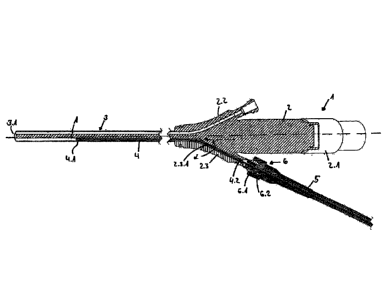Une partie des informations de ce site Web a été fournie par des sources externes. Le gouvernement du Canada n'assume aucune responsabilité concernant la précision, l'actualité ou la fiabilité des informations fournies par les sources externes. Les utilisateurs qui désirent employer cette information devraient consulter directement la source des informations. Le contenu fourni par les sources externes n'est pas assujetti aux exigences sur les langues officielles, la protection des renseignements personnels et l'accessibilité.
L'apparition de différences dans le texte et l'image des Revendications et de l'Abrégé dépend du moment auquel le document est publié. Les textes des Revendications et de l'Abrégé sont affichés :
| (12) Brevet: | (11) CA 3071473 |
|---|---|
| (54) Titre français: | DISPOSITIF ENDOSCOPIQUE |
| (54) Titre anglais: | ENDOSCOPE DEVICE |
| Statut: | Octroyé |
| (51) Classification internationale des brevets (CIB): |
|
|---|---|
| (72) Inventeurs : |
|
| (73) Titulaires : |
|
| (71) Demandeurs : |
|
| (74) Agent: | GOWLING WLG (CANADA) LLP |
| (74) Co-agent: | |
| (45) Délivré: | 2024-04-09 |
| (86) Date de dépôt PCT: | 2018-08-20 |
| (87) Mise à la disponibilité du public: | 2019-03-07 |
| Requête d'examen: | 2023-08-09 |
| Licence disponible: | S.O. |
| (25) Langue des documents déposés: | Anglais |
| Traité de coopération en matière de brevets (PCT): | Oui |
|---|---|
| (86) Numéro de la demande PCT: | PCT/EP2018/000405 |
| (87) Numéro de publication internationale PCT: | WO2019/042578 |
| (85) Entrée nationale: | 2020-01-29 |
| (30) Données de priorité de la demande: | |||||||||
|---|---|---|---|---|---|---|---|---|---|
|
L'invention concerne un dispositif endoscopique destiné à la détermination de l'orientation et du positionnement précis d'un endoscope dans un champ électromagnétique, comprenant une tête d'insertion proximale et, s'étendant distalement de cette dernière, un tube doté d'un axe central qui s'étend avec au moins un lumen allongé à travers le dispositif, caractérisé en ce qu'une tige de détection est pourvue d'au moins deux bobines de détection qui sont mutuellement disposées à une distance finie dans la direction longitudinale et qui sont orientées l'une par rapport à l'autre en formant un angle fini.
The invention proposes, for determining the precise
orientation and positioning of an endoscope in an
electromagnetic field, an endoscope device having a proximal
insertion head and having a shaft extending distally
therefrom having a centre axis, which extends with at least
one oblong lumen through the device, which is characterized
by a sensor rod having at least two sensor coils arranged
with finite spacing in relation to one another in the
longitudinal direction, which are oriented in relation to
one another at a finite angle.
Note : Les revendications sont présentées dans la langue officielle dans laquelle elles ont été soumises.
Note : Les descriptions sont présentées dans la langue officielle dans laquelle elles ont été soumises.

Pour une meilleure compréhension de l'état de la demande ou brevet qui figure sur cette page, la rubrique Mise en garde , et les descriptions de Brevet , États administratifs , Taxes périodiques et Historique des paiements devraient être consultées.
| Titre | Date |
|---|---|
| Date de délivrance prévu | 2024-04-09 |
| (86) Date de dépôt PCT | 2018-08-20 |
| (87) Date de publication PCT | 2019-03-07 |
| (85) Entrée nationale | 2020-01-29 |
| Requête d'examen | 2023-08-09 |
| (45) Délivré | 2024-04-09 |
Il n'y a pas d'historique d'abandonnement
Dernier paiement au montant de 210,51 $ a été reçu le 2023-08-02
Montants des taxes pour le maintien en état à venir
| Description | Date | Montant |
|---|---|---|
| Prochain paiement si taxe applicable aux petites entités | 2024-08-20 | 100,00 $ |
| Prochain paiement si taxe générale | 2024-08-20 | 277,00 $ |
Avis : Si le paiement en totalité n'a pas été reçu au plus tard à la date indiquée, une taxe supplémentaire peut être imposée, soit une des taxes suivantes :
Les taxes sur les brevets sont ajustées au 1er janvier de chaque année. Les montants ci-dessus sont les montants actuels s'ils sont reçus au plus tard le 31 décembre de l'année en cours.
Veuillez vous référer à la page web des
taxes sur les brevets
de l'OPIC pour voir tous les montants actuels des taxes.
| Type de taxes | Anniversaire | Échéance | Montant payé | Date payée |
|---|---|---|---|---|
| Le dépôt d'une demande de brevet | 2020-01-29 | 400,00 $ | 2020-01-29 | |
| Taxe de maintien en état - Demande - nouvelle loi | 2 | 2020-08-20 | 100,00 $ | 2020-07-14 |
| Taxe de maintien en état - Demande - nouvelle loi | 3 | 2021-08-20 | 100,00 $ | 2021-07-28 |
| Taxe de maintien en état - Demande - nouvelle loi | 4 | 2022-08-22 | 100,00 $ | 2022-07-27 |
| Taxe de maintien en état - Demande - nouvelle loi | 5 | 2023-08-21 | 210,51 $ | 2023-08-02 |
| Requête d'examen | 2023-08-21 | 816,00 $ | 2023-08-09 | |
| Taxe finale | 416,00 $ | 2024-02-27 |
Les titulaires actuels et antérieures au dossier sont affichés en ordre alphabétique.
| Titulaires actuels au dossier |
|---|
| JOIMAX GMBH |
| Titulaires antérieures au dossier |
|---|
| S.O. |